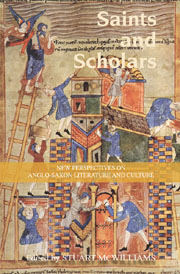 Saints and Scholars
Saints and Scholars Book contents
- Frontmatter
- Contents
- List of Contributors
- Abbreviations
- Introduction
- I Hagiography and the Homiletic Tradition
- II Aspects of Community and Consumption
- 8 Stories from the Court of King Alfred
- 9 De Duodecim Abusiuis, Lordship and Kingship in Anglo-Saxon England
- 10 Reluctant Appetites: Anglo-Saxon Attitudes towards Fasting
- 11 A Note on the Function of the Inscribed Strip from the Staffordshire Hoard
- 12 The Shining of the Sun in the Twelve Nights of Christmas
- 13 Sin and Laughter in Late Anglo-Saxon England: The Case of Old English (h)leahtor
- 14 Marginal Activity? Post-Conquest Old English Readers and their Notes
- III Reflections on Old English Scholarship
- Poems
- Hugh Magennis: A Bibliography, 1981–2011
- Index
- Tabula Gratulatoria
12 - The Shining of the Sun in the Twelve Nights of Christmas
from II - Aspects of Community and Consumption
Published online by Cambridge University Press: 05 February 2013
- Frontmatter
- Contents
- List of Contributors
- Abbreviations
- Introduction
- I Hagiography and the Homiletic Tradition
- II Aspects of Community and Consumption
- 8 Stories from the Court of King Alfred
- 9 De Duodecim Abusiuis, Lordship and Kingship in Anglo-Saxon England
- 10 Reluctant Appetites: Anglo-Saxon Attitudes towards Fasting
- 11 A Note on the Function of the Inscribed Strip from the Staffordshire Hoard
- 12 The Shining of the Sun in the Twelve Nights of Christmas
- 13 Sin and Laughter in Late Anglo-Saxon England: The Case of Old English (h)leahtor
- 14 Marginal Activity? Post-Conquest Old English Readers and their Notes
- III Reflections on Old English Scholarship
- Poems
- Hugh Magennis: A Bibliography, 1981–2011
- Index
- Tabula Gratulatoria
Summary
A Significant corpus of Anglo-Saxon prognostics survives in various eleventh- and twelfth-century manuscripts. Until recently these texts have been erroneously and superficially associated with magic and pagan worship, without regard to the cultural context of the manuscripts which contain them. Scholars have shown a deeper interest in more obviously mainstream monastic works such as homilies and saints' lives, on the assumption that prognostics were not part of that mainstream religious culture of the period.
Another feature which has deterred scholars from sustained engagement with this material is its diversity. It comprises a miscellaneous assortment of texts both in Latin and English, ranging from the occurrence of wind and sun during the twelve nights of Christmas, predictions based on the weather on Christmas Day and New Year's Day, known as the Revelatio Esdrae, to lists of lucky and unlucky days, the prediction of an individual's character and personality from the day of the week in which he was born, dream prophecies, thunder divination, and much besides. Prognostics are calendrical, rather than astrological, in the sense that they are generally placed within a specific time framework which could be the days of the week, months and years.
This remarkable corpus of Old English predictions has remained obscure to modern readers and students until recently. Building on Max Förster's haphazard but valuable series of articles dispersed between Englische Studien and Archiv für das Studium der neueren Sprachen und Literaturen (1903–25), L. S. Chardonnens published, in 2007, the first comprehensive edition of Anglo-Saxon prognostics in both Latin and English.
- Type
- Chapter
- Information
- Saints and ScholarsNew Perspectives on Anglo-Saxon Literature and Culture in Honour of Hugh Magennis, pp. 195 - 212Publisher: Boydell & BrewerPrint publication year: 2012


